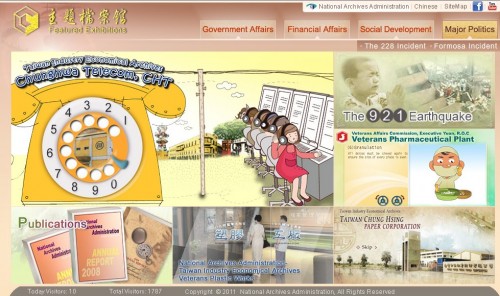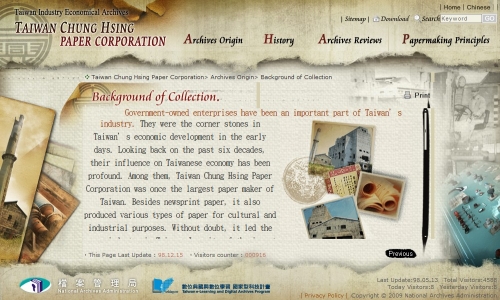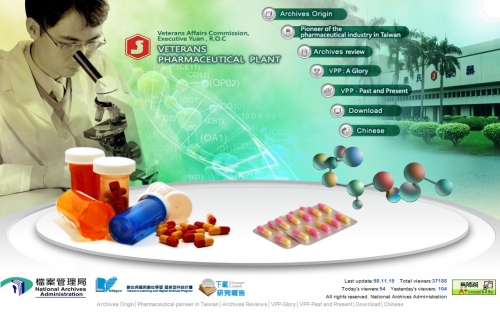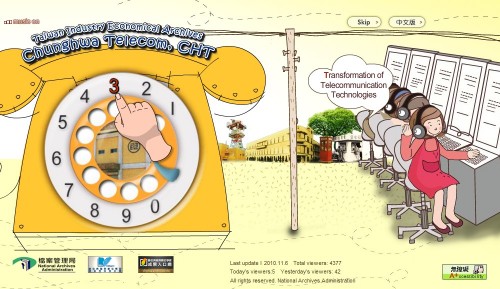|
|

http://theme.archives.gov.tw/en/index.html
|
| |
| Government-owned enterprises have been an important part of Taiwan’s industry. They were the corner stones in Taiwan’s economic development in the post-war period. Their growth reflected the operation and management of the companies, the relationship between manufacturing technology and industries, and the impact of national policies on the social and economic developments in Taiwan. Their history in the past six decades is documentary material for the historical and academic researches. In 2007, National Archives Administration of Executive Yuan embarked on a 6-year program, the “Taiwan Industry and Economy Digital Archives Project,” to digitize and preserve documents of these enterprises so that their stories can be made known to the public. Six companies are briefly presented in this article. |
| |
| 1. Taiwan Chung Hsing Paper Corporation |
| |

|
| |
| Taiwan Chung Hsing Paper Corporation was once the largest paper maker of Taiwan. Besides newsprint paper, it also produced various types of paper for cultural and industrial purposes such as telephone book paper, cigarette paper, textbook paper, simili paper, art paper, typing paper, printing paper, wood-free paper, and Kraft paper. Without doubt, it led the paper industry in Taiwan. In spite of the impact of global fluctuations of paper prices and economic changes, Chung Hsing Paper Corporation continued to supply paper at affordable prices and made sure the government policy of newsprint paper self-sufficiency to cut foreign exchange expenditure was carried out. In the end, however, it started to turn from a profit-making enterprise into a business with increasing deficits. The government decided to privatize it. Eventually, in October 2001, it was reorganized and became Hsing Chung Paper Co., Ltd. to be operated under private ownership. |
| |
| 2. Kaohsiung Ammonium Sulfate Corporation |
| |

|
| |
| The predecessor of the company was the Ordnance Plant 26, established in Hubei Province after the Japanese Resistance War to manufacture gunpowder and fertilizer. In 1949, Plant 26 was relocated to Kaohsiung, Taiwan. Later, the Ordnance Corps proposed to the Taiwanese Provincial Government to transfer the fertilizer production equipment of Plant 26 to the Government in order to produce ammonium sulfate fertilizers (so-called rice paddy enrichment powder) required by the agriculture industry. Hence, the Kaohsiung Ammonium Sulfate Plant was established on January 1, 1950 and was responsible for manufacturing anhydrous ammonia, sulfuric acid, ammonium sulfate, nitric acid, etc. On October 1, 1954, the Plant became the Kaohsiung Ammonium Sulfate Corporation, Ltd. The company contributed significantly towards the development of Taiwan’s early agricultural industry, affecting the livelihoods of many Taiwanese farmers. In 2002, when a privatization tender failed to attract a buyer, the Ministry of Economic Affairs decided to shut down the plant. The company went into receivership on January 1, 2003. |
| |
| 3. Veterans Pharmaceutical Plant |
| |

|
| |
|
In the history of government-owned enterprises development, the Veterans Pharmaceutical Plant (VPP) of the Veterans Affairs Commission, Executive Yuan, has been the supplier of drugs for the Armed Forces, Veterans Affairs hospitals, and various public and private hospitals. Founded in 1960 and privatized on December 31, 2005, VPP has also been a provider of job opportunities and vocational training for veterans, a promoter of national economic development, and a supplier of medical supplies for the Armed Forces.
Drug manufacture is a matter of national health. The organizational changes, product development, and sales achievements of VPP witnessed the history of pharmaceutical development in postwar Taiwan and the improvement of pharmaceutical quality. The frustrations that VPP underwent during the privatization period also reveal the bottlenecks of Taiwan’s pharmaceutical industry. For these reasons, VPP is a good example for the case study of Taiwan’s pharmaceutical industry development.
|
| |
|
4. Veterans Plastic Works
|
| |

|
| |
|
The Veterans Plastic Works was officially established on February 1, 1972 and its two production lines of injection molding and extrusion blow-molding of bags began to operate by May of that year. The company was one of the government-owned enterprises of retired servicemen system, with factory staff composed mostly of veterans and the core products manufactured closely relating to national defense and state-operated systems. The products included PE heavy duty sacks (fertilizers, refined salts), anti-stain membranes, heat-shrink films, PE protective films, agriculture-use membranes, PS membranes and K glue shrink membranes, general purpose PE bags, dairy product packing, and espionage balloons.
Throughout the era of economic liberalization and globalization, the capitals and technology of private enterprises flourished which severely challenged the operation system and development of government-owned enterprises. Veterans Plastic Works gradually lost its competitive edge. Finally in 2003, when it could not reform to become a private enterprise, it stopped its business.
|
| |
|
5. Taiwan Salt Industrial Corporation (Taiyen)
|
| |

|
| |
|
According to the location of saltern heritages and historical records, Taiwan’s salt industry started before the Ming Dynasty. A stele with inscriptions made by a Yuan Dynasty official, stating the construction of salt fields in Wuzhou, Kinmen, was found on Taiwu Mountain in Kinmen. In late Ming, Chen Yong-Hua, a trusted advisor to Cheng Cheng-Kung, was said to have taught local residents to rebuild the Laikou Salt Field and improve the method of solar salt production during the reign of Cheng. It was the beginning of Taiwan’s solar salt production. During World War I (1914-1918), the Japanese government worked to reorganize the existing salt fields and build new ones in central and southern Taiwan to meet the military and industrial demands.
Since the Japanese Colonial period, Taiyen was a monopoly enterprise regarding salt production and sales. The operations of Taiwan Salt Works (later renamed Taiwan Salt Industrial Corporation and then Taiyen), including property transfer from Japanese government, reorganization and management of thousands of local salt-making workers and professionals and salt taxation policemen from mainland China, as well as development of salt fields south of Changhua, all had a significant impact on Taiwan’s economy and social changes. Taiwan Salt Industrial Corporation was privatized on November 13, 2003 and became Taiyen.
|
| |
|
6. Chunghwa Telecom, CHT
|
| |

|
| |
In 1877, for the purpose of military communications, the Qing government constructed two telegraph lines in Taiwan, marking the beginning of Taiwan’s telecommunication age. In 1886, the Governor of Taiwan set up the Telegraph Office in Taipei and completed a submarine cable from Tamsui to Fuzhou, Fujian Province. In 1888, a line connecting Taipei, Hsinchu, Miaoli, Changhua, Yunlin, Chiayi, and Tainan was constructed. It became Taiwan’s first commercial telegraph line. In 1897, Taiwan’s first fixed telephone line and first long-distance telephone line were set up by the Japanese authorities. The number of telephone subscribers steadily increased over the years and it went soaring after the war. Chunghwa Telecom launched satellite communications network in the 1960s and began service of leased data transmission lines in 1972, marking the beginning of a new technology era.
Chunghwa Telecom Co., Ltd. (Chunghwa Telecom, CHT) was reorganized in 1981, turned into a corporation in 1996, and became completely privatized on August 12, 2005, transforming itself from a monopoly enterprise to an independent corporation with offices and service units across the country. |
|
|
|
| Text and images are provided by National Archives Administration |
| |
|